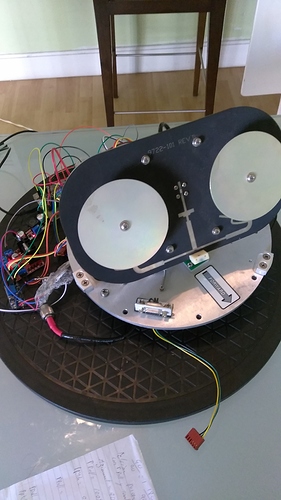This is what I had in mind as a first until I read the patch antenna had a 25degree lobe. Then switching best RSSI.
Exactly, for ease of reproduction a microstrip combiner with Inmarsat filter. Datasheets like from these; http://www.tallysman.com/index.php/gnss/products/ suggest 30MHz BW at 1dB point. Is it a module like these that you hacked?
Very cool site.
looks like I was lucky on 2nd and 3rd  “Triple loaded-dipole antennas for isotropic coverage (1500 MHz)”
“Triple loaded-dipole antennas for isotropic coverage (1500 MHz)”
wow, the first is for direction finding? "L-Band hemispherical array for direction/polarization sensing"
I guess aircraft…
similar to this one http://r.ebay.com/fM9IvU which is an active antenna. Filter removal and bridging is detailed here:
http://www.rtl-sdr.com/rtl-sdr-tutorial-decoding-inmarsat-std-c-egc-messages/
I plan to try this one next:
http://www.readytoflyquads.com/high-gain-gps-active-ceramic-patch-antenna-45x45
For an array, I would use these mounted to a backplane, properly spaced, combined with a phasing harness and feeding the Outernet LNA/Filter: http://r.ebay.com/TRB04o
If you are looking for a nice and simple design for a marine L-band antenna, you could take a look at the inside of a Thrane&Thrane Inmarsat C antenna.
It’s built for emergency communication with no moving parts and for the correct frequency’s and polarization, and have a 360 degree azimuth and down to -15 elevation coverage.
And looking at the design it should not be so hard to replicate, as it is only built on a ordinary PCB.
Combine it with a LNA and it should work fine both for merchant and leisure ships.
OK, then I´ll opt to be patient and see what your results are. Have asked around att one university if there is interest to help out with microstrip combiner and filter. More patience.
Thanks for input. Cobham bought Thrane&Thrane back in 2012. Such an antenna is not readily accessible to me unfortunately. With C-band things gets so much smaller…
Pretty sure it’s a quadrifilar helix in a radome, with a good LNA.
What do you mean by that?
Wavelength is shorter, antennas physically smaller for same gain. L-band is around 1,5GHz with wavelengths around 6-12inches, C-band range is 4-8 GHz. Inch long wavelengths are in the Ku-band (most VSAT geostationary coms) at 12-18GHz and then K and Ka above that. The atmospheric benefits are better for the lower bands, at Ka rain can destroy the link easily. No free lunch at all.
Found a good paper here http://orbanmicrowave.com/wp-content/uploads/2015/03/TheBasicsofQuadrifilarHelixAntennas.pdf
Good article.
I luckly bought a kvh 25 for 40$ and changed the circuit to convert it to an internet antenna… Those where designed for L band… so in theory it should work nicely…
Any luck as a Outernet antenna?
Right now it stabilizes correctly, the only issue is finding the north, but if its oriented manually… keeps the orientation no matter what you do. So in theory good enough. I’ll make a webpage with the materials and code when it’s finished.
Can you get the North NMEA data out of your autopilot, calculated from your flux gate compass.
Finding north can be challenging, i have 5 avl-1278 dishes, but no controllers so i built my own positioners with Rpi +lm298 pwm etc. To get north i use a hmc5883l 3 axis mag sensor and the world magnetic model to adjust for declination based on gps position. It then computes exact az, el and polarity for a given satellite position.
Point being that once the mag sensor is adjusted for declination via the model it was incredibly accurate.
Chris
Here a link to a writeup about the dish software…
That’s exactly what I’m trying to build… but gyrostabilized. How did you calibrate de magnetometer… ellipsoid fit?.. max min?. The calculation of the orientation knowing sat POS, GPS and true north looks challenging. Do you have a project page?.
